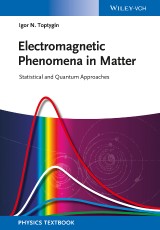Details

Electromagnetic Phenomena in Matter
Statistical and Quantum Approaches1. Aufl.
|
120,99 € |
|
| Verlag: | Wiley-VCH |
| Format: | EPUB |
| Veröffentl.: | 19.03.2015 |
| ISBN/EAN: | 9783527413188 |
| Sprache: | englisch |
| Anzahl Seiten: | 720 |
DRM-geschütztes eBook, Sie benötigen z.B. Adobe Digital Editions und eine Adobe ID zum Lesen.
Beschreibungen
Modern electrodynamics in different media is a wide branch of electrodynamics which combines the exact theory of electromagnetic fields in the presence of electric charges and currents with statistical description of these fields in gases, plasmas, liquids and solids; dielectrics, conductors and superconductors. It is widely used in physics and in other natural sciences (such as astrophysics and geophysics, biophysics, ecology and evolution of terrestrial climate), and in various technological applications (radio electronics, technology of artificial materials, laser-based technological processes, propagation of bunches of charges particles, linear and nonlinear electromagnetic waves, etc.). Electrodynamics of matter is based on the exact fundamental (microscopic) electrodynamics but is supplemented with specific descriptions of electromagnetic fields in various media using the methods of statistical physics, quantum mechanics, physics of condensed matter (including theory of superconductivity), physical kinetics and plasma physics.<br> This book presents in one unique volume a systematic description of the main electrodynamic phenomena in matter:<br> - A large variety of theoretical approaches used in describing various media<br> - Numerous important manifestations of electrodynamics in matter (magnetic materials, superconductivity, magnetic hydrodynamics, holography, radiation in crystals, solitons, etc.)<br> - A description of the applications used in different branches of physics and many other fields of natural sciences<br> - Describes the whole complexity of electrodynamics in matter including material at different levels. <br> - Oriented towards 3-4 year bachelors, masters, and PhD students, as well as lectures, and engineers and scientists working in the field.<br> - The reader will need a basic knowledge of general physics, higher mathematics, classical mechanics and microscopic (fundamental) electrodynamics at the standard university level<br> - All examples and problems are described in detail in the text to help the reader learn how to solve problems<br> - Advanced problems are marked with one asterisk, and the most advanced ones with two asterisks. Some problems are recommended to be solved first, and are are marked by filled dots; they are more general and important or contain results used in other problems.<br>
<p>Preface IX</p> <p>Basis Notations XIII</p> <p><b>Fundamental Constants and Frequently Used Numbers XVII</b></p> <p><b>1 Equations of Steady Electric and Magnetic Fields in Media 1</b></p> <p>1.1 Averaging Microscopic Maxwell Equations. Vectors of Electromagnetic Fields in Media 2</p> <p>1.2 Equations of Electrostatics and Magnetostatics in Medium 4</p> <p>1.3 Polarization of Media in a Constant Field 7</p> <p>Problems 12</p> <p>1.4 Answers and Solutions 17</p> <p><b>2 Electrostatics of Conductors and Dielectrics 37</b></p> <p>2.1 Basic Concepts and Methods of Electrostatics 37</p> <p>Problems 41</p> <p>2.2 Special Methods of Electrostatics 45</p> <p>Problems 54</p> <p>2.3 Energy, Forces, and Thermodynamic Relations for Conductors and Dielectrics 59</p> <p>Problems 71</p> <p>2.4 Answers and Solutions 76</p> <p><b>3 Stationary Currents and Magnetic Fields in Media 115</b></p> <p>3.1 Stationary Current 115</p> <p>Problems 123</p> <p>3.2 Magnetic Field in Magnetic Media 129</p> <p>Problems 131</p> <p>3.3 Energy, Forces, and Thermodynamic Relations for Magnetics 133</p> <p>Problems 145</p> <p>3.4 Electric and Magnetic Properties of Superconductors 149</p> <p>Problems 153</p> <p>Problems 155</p> <p>Problems 160</p> <p>3.5 Answers and Solutions 164</p> <p><b>4 Quasi-Stationary Electromagnetic Field 193</b></p> <p>4.1 Quasi-Stationary Phenomena in Linear Conductors 193</p> <p>Problems 197</p> <p>4.2 Eddy Currents and Skin-Effect 201</p> <p>Problems 205</p> <p>4.3 Magnetic Hydrodynamics 207</p> <p>Problems 222</p> <p>4.4 Answers and Solutions 228</p> <p><b>5 Maxwell Equations for Alternating and Inhomogeneous Fields 275</b></p> <p>5.1 Different Forms of Maxwell Equations in Media. Coupling Equations and Electromagnetic Response Functions 275</p> <p>Problems 287</p> <p>5.2 Causality Principle and Dispersion Relations 291</p> <p>Problems 296</p> <p>5.3 Energy Relations for Alternating Electromagnetic Field in Media. Longitudinal Electric Oscillations 297</p> <p>Problems 302</p> <p>5.4 Magnetic Oscillations and Magnetic Resonance 304</p> <p>Problems 306</p> <p>5.5 Electrodynamics of Moving Media 308</p> <p>Problems 311</p> <p>Problems 321</p> <p>5.6 Energy–Momentum Tensor in Dispersive Media 322</p> <p>Problems 327</p> <p>5.7 Answers and Solutions 327</p> <p><b>6 Propagation of Electromagnetic Waves 363</b></p> <p>6.1 Transverse Waves in Isotropic Media. Reflection and Refraction of Waves 363</p> <p>Problems 377</p> <p>6.2 Plane Waves in Anisotropic and Gyrotropic Media 382</p> <p>Problems 387</p> <p>6.3 Scattering of Electromagnetic Waves by Macroscopic Bodies. Diffraction 390</p> <p>Problem 393</p> <p>Problems 401</p> <p>6.4 Diffraction of X-Rays 405</p> <p>Problems 408</p> <p>6.5 Answers and Solutions 410</p> <p><b>7 Coherence and Nonlinear Waves 463</b></p> <p>7.1 Coherence and Interference 463</p> <p>Problems 472</p> <p>7.2 Random Waves and Waves in Randomly Inhomogeneous Media 477</p> <p>Problems 489</p> <p>7.3 Waves in Nonlinear and Active Media 490</p> <p>Problems 503</p> <p>7.4 Answers and Solutions 504</p> <p><b>8 Electromagnetic Oscillations in Finite Bodies 521</b></p> <p>8.1 Electromagnetic Waves in Waveguides 521</p> <p>Problems 524</p> <p>8.2 Electromagnetic Oscillations in Resonators 530</p> <p>Problems 531</p> <p>8.3 Answers and Solutions 536</p> <p><b>9 Interaction of Charged Particles with Equilibrium and Nonequilibrium Media 565</b></p> <p>9.1 Ionization and Radiation Energy Losses of Fast Particles in Media 565</p> <p>Problems 590</p> <p>9.2 Macroscopic Mechanisms of Radiation of Fast Particles in Media 591</p> <p>Problems 605</p> <p>9.3 Channeling and Radiation Emitted by Fast Particles in Crystals 609</p> <p>Problems 624</p> <p>9.4 Acceleration of Particles in Turbulent Plasma Media 624</p> <p>Problems 647</p> <p>9.5 Answers and Solutions 649</p> <p>Appendix: Turbulence and Its Description with the Aid of Correlation Tensors 681</p> <p>Bibliography 689</p> <p>Index 697</p>
Igor N.Toptygin is Professor at the Theoretical Physics Department in Saint-Petersburg State Polytechnic University, Russia. He received his academic degrees in the field of physics and mathematics in 1964 (PhD) and 1974 (habilitation). He is an expert in theoretical physics and theoretical astrophysics. He is a member of the Scientific Council on Complex Problem of Cosmic Rays of the Russian Academy of Sciences, and a corresponding member of the International Academy of Sciences for High Education. He has been engaged for many years in theoretical studies of quantum paramagnetic amplifiers, acceleration of cosmic rays, and radiation of relativistic particles in plasmas. <br> <br> <br>

















